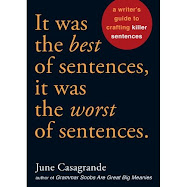From my June 2007 entry:
To read the back cover of Strunk and White's "The Elements of Style," you'd
think it was God's gift to the English-speaking world -- "excellent,"
"timeless," "delightful," "… should be the daily companion of anyone who writes
for a living and, for that matter, anyone who writes at all."
That's a lot of sunshine blowing around. But something about the beloved
nature of this little book has always sat funny with me. For one thing, most
other style reference books get updated from time to time. But "The Elements of
Style's" status as a "classic" means no one dare touch it (except maybe to add pictures) -- even when its prescriptions become ridiculously out of date.
But there was something else that bothered me about this "beloved" little
book that I was never able to put my finger on until I scored a copy of the
original "Elements of Style" by Cornell professor William Strunk, Jr., long
before his student E.B. White landed the job of revising it.
Consider this excerpt in the original "Elements of Style" entry on headings.
"Leave a blank line, or its equivalent in space, after the title or heading of a
manuscript. On succeeding pages, if using ruled paper, begin on the first
line."
Ruled paper? Now, I had always known that "The Elements of Style" was born
of a college classroom. But it never really occurred to me what a fraud was
perpetrated on the reading public when White "revised" the thing.
Basically, White's task was to take a book written for a small and specific
group of students and make it marketable to you and me. Sure, this happened
because the original "Elements of Style" had already found an audience outside
Strunk's classroom. It sort of caught on like wildfire. But White nonetheless
pulled a fast one on us when he tried to make Strunk's student instructions
required reading for everyone who might ever hold a pen.
For example, before Strunk's passage about headers, White inserted: "If the
manuscript is to be submitted for publication …" Then White nixed that reference
to "ruled paper," knowing full well that newspaper editors, resume writers and
business-correspondence writers who were the book's new target market don't use
ruled paper.
Strunk never meant "The Elements of Style" to be a book of iron-clad
rules for you and me: "This book … aims to lighten the task of instructor and
student by concentrating attention … on a few essentials."
Yes, "The Elements of Style" contains some great wisdom, mixed in with some
old-fashioned silliness. But unless you're a Cornell student stuck in a time
warp, don't consider it an ultimate authority.





No comments:
Post a Comment